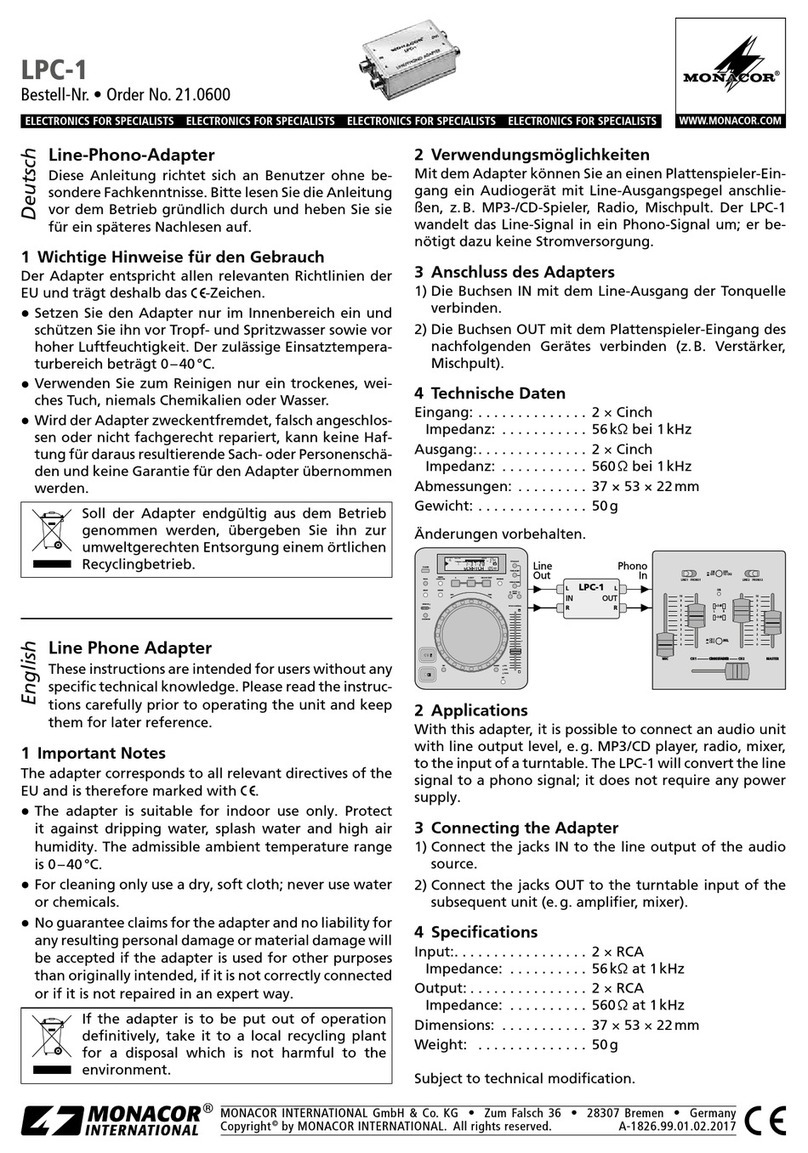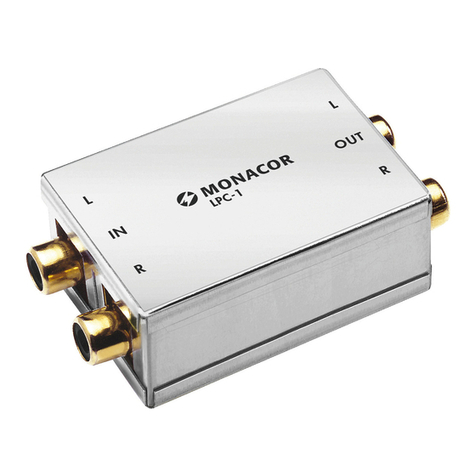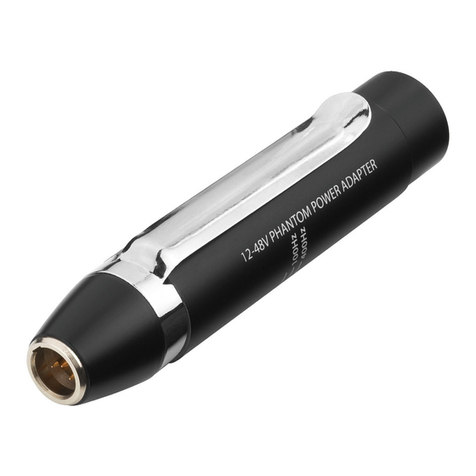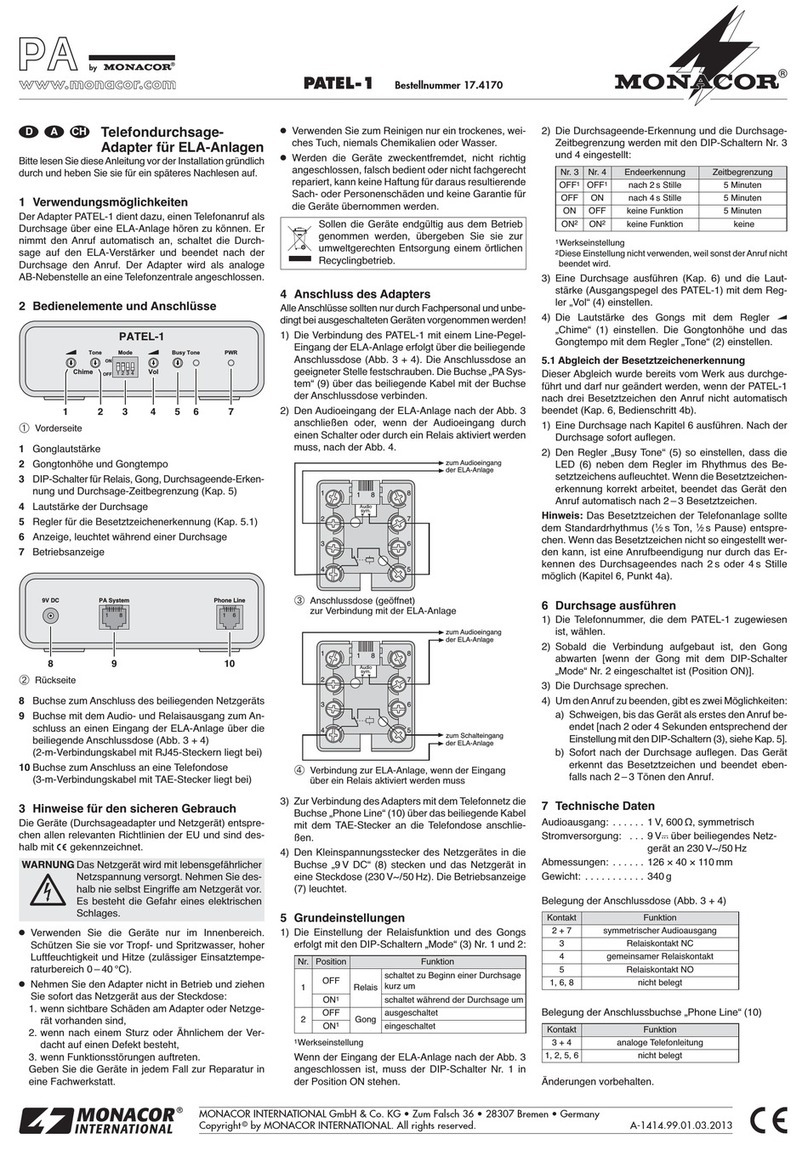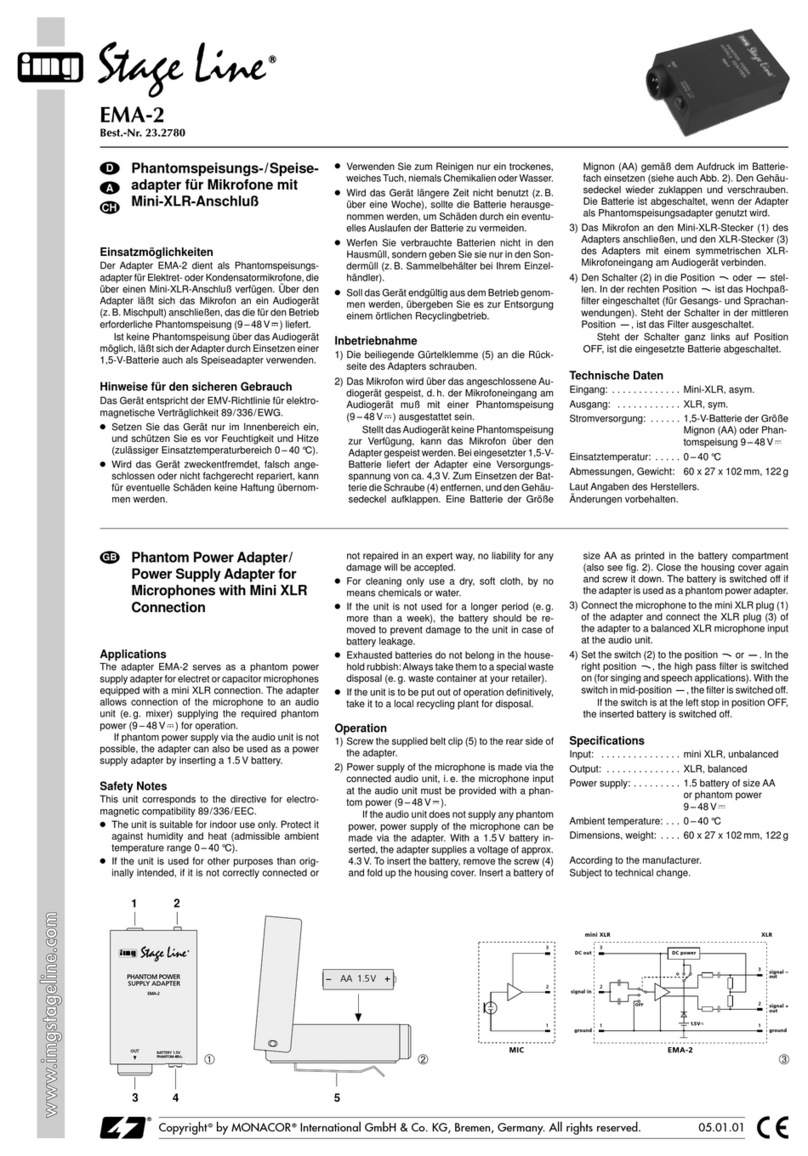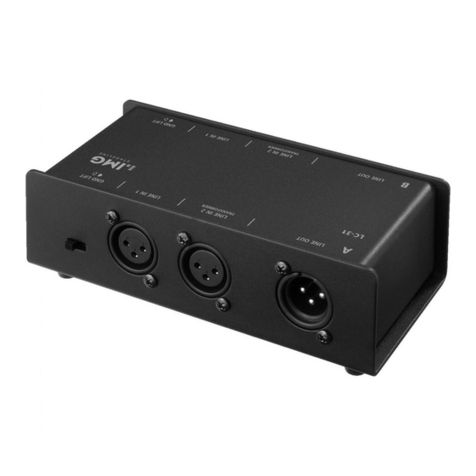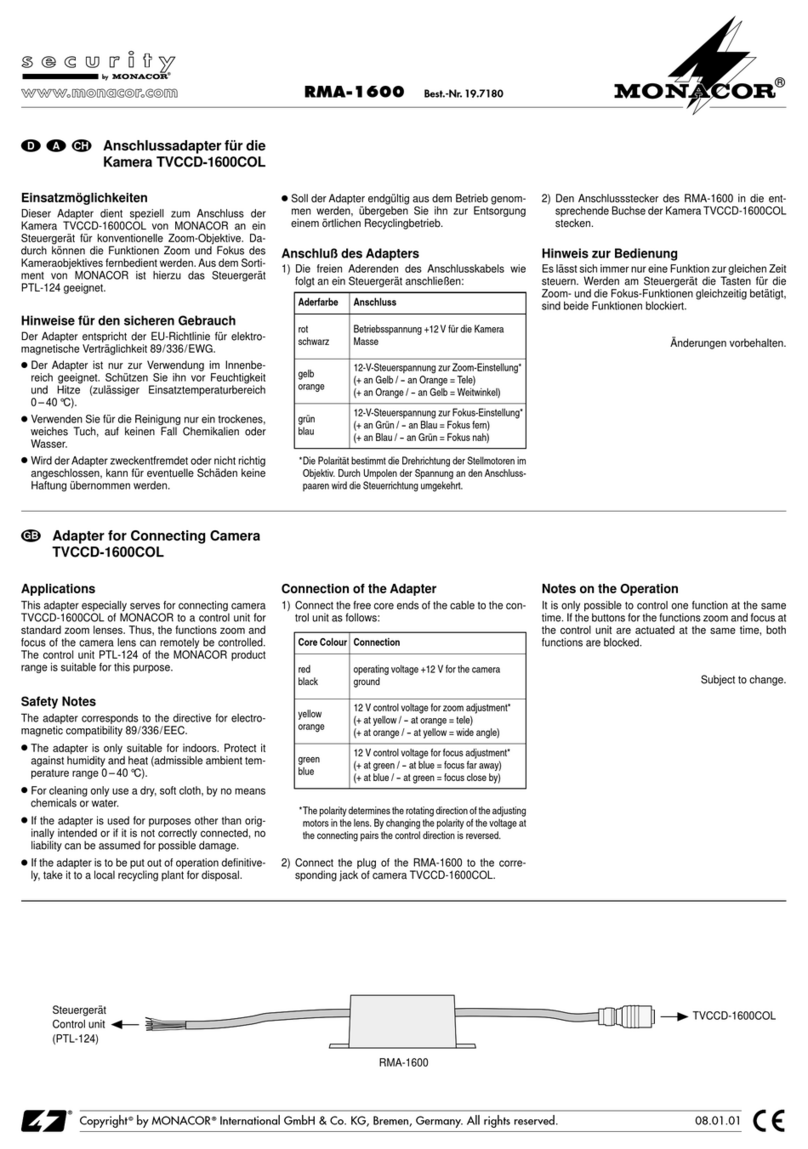Adaptateur de mixage
pour signaux ligne
2 canaux
Veuillez lire la présente notice avec attention
avant le fonctionnement et conservez-la pour
pouvoir vous y reporter ultérieurement.
1 Possibilités dʼutilisation
Le LC-31 est conçu pour mixer ensemble deux
signaux ligne en un seul. Il a deux voies indé-
pendantes (A et B) de sorte que par exemple les
sorties stéréo de deux tables de mixage puissent
être reliées à lʼentrée stéréo dʼun amplificateur.
Pour la séparation galvanique des deux
sources de signal, un signal dʼentrée est res-
pectivement dirigé via un transformateur. En
plus, la masse du signal de cette entrée décou-
plée peut être séparée de la masse de la sortie
et de la masse de lʼautre entrée grâce à un inter-
rupteur. Ainsi, un bouclage de masse pouvant
causer un ronflement perturbateur peut être
interrompu. Il se crée par exemple lorsque deux
sources de signaux ont un contact dans le rack
non seulement via la masse de signal mais aussi
via le conducteur terre de lʼalimentation ou via
une connexion conductrice des boîtiers.
2 Conseils importants dʼutilisation
Cet appareil répond à toutes les directives
nécessaires de lʼUnion Européenne et porte
donc le symbole .
GLʼappareil nʼest conçu que pour une utilisation
en intérieur. Protégez-le de tout type de projec-
tions dʼeau, des éclabossures, dʼune humidité
élevée dʼair et de la chaleur (plage de tempé-
rature de fonctionnement autorisée : 0 – 40 °C).
GPour le nettoyage, utilisez uniquement un chif-
fon sec et doux, en aucun cas de produits chi-
miques ou dʼeau.
GNous déclinons toute responsabilité en cas de
dommages matériels ou corporels résultants
si lʼappareil est utilisé dans un but autre que
celui pour lequel il a été conçu, sʼil nʼest pas
correctement branché, utilisé ou nʼest pas
réparé par une personne habilitée, en outre, la
garantie deviendrait caduque.
3 Branchements
1) Pour éviter tout bruit de commutation, étei-
gnez tout dʼabord les appareils à relier aux sor-
ties ou coupez leurs entrées ou diminuez-les.
Lorsque l’appareil est définitivement retiré
du marché, vous devez le déposer dans
une usine de recyclage adaptée pour
contribuer à son élimination non polluante.
2) Reliez les sorties de la première source audio
aux prises dʼentrée LINE IN 1 (2).
3) Reliez les sorties de la seconde source audio
aux prises dʼentrée LINE IN 2 (3). Cette en-
trée est séparée galvaniquement de la pre-
mière entrée et de la sortie par un transfor-
mateur. La liaison masse de ce branchement
peut, en plus, être séparée de la masse des
branchements LINE IN 1 (2) et LINE OUT (4)
avec lʼinterrupteur Groundlift.
4) Reliez la sortie correspondante LINE OUT (4)
à lʼentrée de lʼappareil audio suivant (par
exemple table de mixage, amplificateur).
5) Si besoin, mettez lʼinterrupteur Groundlift cor-
respondant (1) de la position GND sur la posi-
tion LIFT (masses séparées).
4 Caractéristiques techniques
Résistances de découplage : . . . . . 1 kΩ
Impédance source optimale : . . . . . 50 – 600 Ω
Impédance charge optimale : . . . . . ≥ 5 kΩ
Propriétés du transformateur
Bande passante : . . . . . . . . . . . . 20 – 20 000 Hz
Impédance : . . . . . . . . . . . . . . . . 600 Ωà 1 kHz
Tension d’entrée maximale pour
taux de distorsion 1 %, 40 Hz : . . 5 V
Dimensions : . . . . . . . . . . . . . . . . . . 160 × 55 × 85 mm
Poids : . . . . . . . . . . . . . . . . . . . . . . . 780 g
Tout droit de modification réservé.
Miscelatore di segnali di linea a
2 canali
Vi preghiamo di leggere attentamente le pre-
senti istruzioni prima della messa in funzione e
di conservarle per un uso futuro.
1 Possibilità dʼimpiego
LʼLC-31 è stato realizzato per miscelare due
segnali di linea in un solo segnale. Possiede due
vie indipendenti di segnali (A e B), in modo che
le uscite stereo di due mixer possono essere col-
legate con lʼingresso stereo di un amplificatore.
Per ottenere la separazione galvanica delle
due sorgenti di segnali, un segnale dʼingresso
viene portato attraverso un trasformatore. In più
è possibile, per mezzo di un interruttore, separa-
re la massa del segnale di detto ingresso disac-
coppiato dalla massa dellʼuscita e dalla massa
dellʼaltro ingresso. In questo modo è possibile
aprire un anello di terra che può provocare un
ronzio fastidioso. Tale anello si crea per esem-
pio se entrambe le sorgenti di segnali sono in
contatto nel rack sia attraverso la massa dei
segnali che attraverso il conduttore di terra del-
lʼalimentazione oppure attraverso un collega-
mento conduttivo dei contenitori.
2 Avvertenze importanti per lʼuso
Questʼapparecchio è conforme a tutte le direttive
rilevanti dellʼUE e pertanto porta la sigla .
GUsare lʼapparecchio solo allʼinterno di locali.
Proteggerlo dallʼacqua gocciolante e dagli
spruzzi dʼacqua, da alta umidità dellʼaria e dal
calore (temperatura dʼimpiego ammessa fra
0 e 40 °C).
GPer la pulizia usare solo un panno morbido,
asciutto; non impiegare in nessun caso pro-
dotti chimici o acqua.
GNel caso dʼuso improprio, di collegamenti sba-
gliati, dʼimpiego scorretto o di riparazione non
a regola dʼarte dellʼapparecchio, non si assume
nessuna responsabilità per eventuali danni
consequenziali a persone o a cose e non si
assume nessuna garanzia per lʼapparecchio.
3 Eseguire i collegamenti
1) Per escludere rumori di collegamento con-
viene spegnere dapprima gli apparecchi da
collegare con le uscite o mettere su muto o
abbassare i loro ingressi.
2) Collegare le uscite della prima sorgente audio
con le prese dʼingresso LINE IN 1 (2).
3) Collegare le uscite della seconda sorgente
audio con le prese dʼingresso LINE IN 2 (3).
Se si desidera eliminare lʼapparecchio
definitivamente, consegnarlo per lo
smaltimento ad unʼistituzione locale
per il riciclaggio.
Per mezzo di un trasformatore, questo
ingresso dispone di separazione galvanica
dal primo ingresso e dallʼuscita. Inoltre, il col-
legamento di massa di detto collegamento
può essere separato dalla massa dei contatti
LINE IN 1 (2) e LINE OUT (4) con lʼaiuto di un
interruttore groundlift.
4) Collegare la relativa uscita LINE OUT (4)
con lʼingresso dellʼapparecchio audio a valle
(p. es. amplificatore, mixer).
5) Se necessario, spostare il relativo interruttore
groundlift (1) dalla posizione GND in posi-
zione LIFT (masse separate).
4 Dati tecnici
Resistenze di disaccoppiamento: . . 1 kΩ
Impedenza ottimale della sorgente: . 50 – 600 Ω
Impedenza ottimale del carico: . . . . ≥ 5 kΩ
Caratteristiche del trasformatore
Gamma di frequenze: . . . . . . . . . 20 – 20 000 Hz
Impedenza: . . . . . . . . . . . . . . . . . 600 Ωcon 1 kHz
Tensione max. d’ingresso con
fattore di distorsione 1 %, 40 Hz: 5 V
Dimensioni: . . . . . . . . . . . . . . . . . . . 160 × 55 × 85 mm
Peso: . . . . . . . . . . . . . . . . . . . . . . . . 780 g
Con riserva di modifiche tecniche.
I
LC-31
Best.-Nr. 25.1670
www.imgstageline.com
